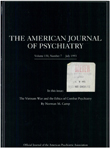A placebo-controlled, double-blind crossover study of fluoxetine in trichotillomania
Abstract
OBJECTIVE: It has been proposed by some investigators that trichotillomania, a disorder of chronic hair pulling, is a variant of obsessive-compulsive disorder, and some studies have suggested that the antiobessional agents clomipramine and fluoxetine are useful in treating this disorder. The authors investigated the efficacy of fluoxetine in the treatment of trichotillomania. METHOD: Twenty-one adult chronic hair pullers were recruited into an 18-week placebo- controlled, double-blind crossover study of fluoxetine, in doses up to 80 mg/day. The fluoxetine and placebo treatment phases consisted of 6- week trials of each agent separated by a 5-week washout period. Fifteen subjects (14 female and one male) completed the study; an additional female subject dropped out at 16 weeks after developing a drug reaction. RESULTS: No significant Drug by Period interactions were found in weekly subject ratings of hair pulling, weekly subject ratings of the urge to pull hair, weekly assessments of the number of hair- pulling episodes, or the estimated amount of hair pulled per week. CONCLUSIONS: The short-term efficacy of fluoxetine in the treatment of trichotillomania was not demonstrated in this study.
Access content
To read the fulltext, please use one of the options below to sign in or purchase access.- Personal login
- Institutional Login
- Sign in via OpenAthens
- Register for access
-
Please login/register if you wish to pair your device and check access availability.
Not a subscriber?
PsychiatryOnline subscription options offer access to the DSM-5 library, books, journals, CME, and patient resources. This all-in-one virtual library provides psychiatrists and mental health professionals with key resources for diagnosis, treatment, research, and professional development.
Need more help? PsychiatryOnline Customer Service may be reached by emailing [email protected] or by calling 800-368-5777 (in the U.S.) or 703-907-7322 (outside the U.S.).



